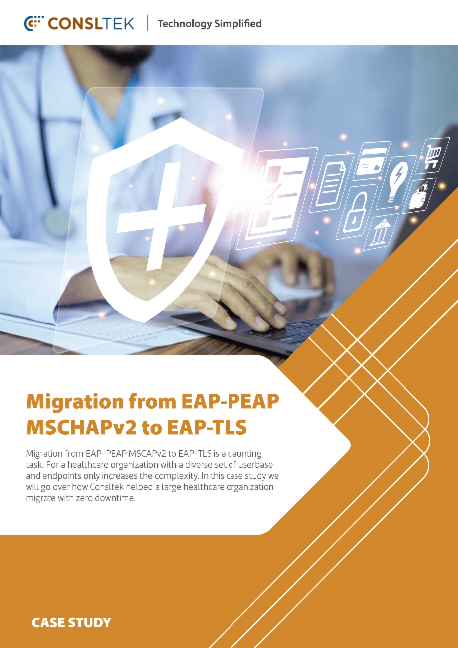- Introduction: Elevating Healthcare Cybersecurity
- Understanding NGFW: A Paradigm Shift in Network Security
- The Core Attributes of NGFWs: Building a Fortified Defense
- Integrating NGFWs with Existing Infrastructure
- Deploying NGFWs: Types and Considerations
- Choosing an NGFW Vendor
- NGFW Management: Best Practices for Optimal Security
- Addressing Advanced Security Concerns
- Future-Proofing Healthcare Cybersecurity with NGFWs
- Conclusion: A Call to Action for Healthcare Cybersecurity Excellence
Introduction: Elevating Healthcare Cybersecurity
In an increasingly digitized world, healthcare institutions face a daunting challenge: safeguarding sensitive patient data while adhering to stringent regulatory requirements.
The stakes are high, as breaches can compromise patient privacy, disrupt medical services, and erode public trust.
Four Reasons Why Robust Cybersecurity Is Essential For Healthcare
- Patient Confidentiality: Healthcare organizations store a wealth of personal information, from medical histories to insurance details. Ensuring patient confidentiality is not just a legal obligation- it’s a fundamental ethical responsibility.
- Regulatory Compliance: Stricter regulations, such as the Health Insurance Portability and Accountability Act (HIPAA) and the General Data Protection Regulation (GDPR), demand rigorous cybersecurity practices. Non-compliance can result in hefty fines and reputational damage.
- Emerging Threat Landscape: Cyberattacks are on the rise, with ransomware, data breaches, and phishing schemes targeting vulnerable healthcare systems. The consequences can be dire, affecting patient care and organizational stability.
- Interconnected Ecosystem: Healthcare networks link hospitals, clinics, laboratories, and telemedicine platforms. A breach in one area can cascade across the entire ecosystem, jeopardizing patient safety and operational continuity.
The Pressing Need For Healthcare
Healthcare leaders must prioritize cybersecurity as a strategic imperative.
Robust measures, including encryption, access controls, regular audits, and employee training, are non-negotiable. Collaboration between IT experts, clinicians, and administrators is crucial to fortify defenses.
In this era of digital health, elevating cybersecurity isn’t an option—it’s a lifeline for patients, providers, and the integrity of our healthcare system.
NGFWs represent a paradigm shift—a departure from rigid rule-based firewalls toward dynamic, context-aware protection. In healthcare, where patient trust and data security are paramount, embracing NGFWs is essential.
Understanding NGFW: A Paradigm Shift in Network Security

Next-Generation Firewalls (NGFWs) have emerged as a game-changer, especially within healthcare environments.
Let’s explore what sets NGFWs apart from traditional firewalls and explore their critical role in safeguarding sensitive patient data.
The Evolution from Traditional to Next-Generation Firewalls
Traditional firewalls primarily focus on packet filtering—allowing or blocking traffic based on predefined rules. While effective for basic security, they fall short in today’s complex threat landscape.
Here’s where NGFWs step in:
- Deep Packet Inspection (DPI): NGFWs go beyond simple rule-based filtering. They inspect packets at the application layer, analyzing content and context. This enables them to identify not only protocols but also specific applications and even user behavior.
- Application Awareness: NGFWs understand the nuances of applications. For instance, they can differentiate between legitimate web traffic and malicious file transfers within the same HTTP stream. This granularity enhances security without compromising performance.
- Intrusion Prevention System (IPS): NGFWs integrate IPS capabilities, actively detecting and blocking known vulnerabilities and exploits. They keep pace with emerging threats by leveraging threat intelligence feeds.
- User Identity Awareness: NGFWs tie network activity to specific users. This user-centric approach allows fine-grained access control based on roles, ensuring that authorized personnel can access necessary resources while maintaining security.
NGFWs and Healthcare Compliance
Healthcare organizations face unique compliance challenges due to the sensitive nature of patient data. NGFWs play a pivotal role in meeting these requirements:
- HIPAA Compliance: The Health Insurance Portability and Accountability Act (HIPAA) mandates strict safeguards for protected health information (PHI). NGFWs contribute by:
- Encryption Inspection: NGFWs decrypt and inspect encrypted traffic, ensuring compliance without compromising privacy.
- Access Controls: They enforce granular access policies, limiting PHI exposure to authorized personnel.
- Audit Trails: NGFWs maintain detailed logs, aiding in compliance audits.
- Advanced Threat Protection: NGFWs detect and prevent malware, ransomware, and zero-day attacks. Their ability to analyze traffic at the application layer helps identify suspicious behavior early.
- Segmentation and Isolation: NGFWs allow network segmentation, isolating critical systems (such as electronic health records) from less sensitive areas. This containment strategy limits the impact of breaches.
NGFWs represent a paradigm shift—a departure from rigid rule-based firewalls toward dynamic, context-aware protection. In healthcare, where patient trust and data security are paramount, embracing NGFWs is essential.
IDC predicts that by 2024, 75% of new firewall purchases will be NGFWs, emphasizing the shift towards advanced security features.
The Core Attributes of NGFWs: Building a Fortified Defense

Next-Generation Firewalls (NGFWs) have emerged as indispensable sentinels, especially within healthcare institutions.
Let’s explore the essential attributes that set NGFWs apart and their critical role in safeguarding sensitive patient data.
Statefulness and Beyond
Traditional firewalls operate at the network layer, evaluating packets based on source and destination addresses. NGFWs transcend this limitation by introducing statefulness.
They maintain context about active connections, allowing them to make informed decisions based on the state of the traffic. This context-aware approach enhances security and enables features like deep packet inspection.
Unified Threat Management (UTM)
NGFWs go beyond mere packet filtering. They integrate multiple security functions into a single platform. UTM features include:
- Antivirus: Scanning for known malware signatures.
- URL Filtering: Blocking access to malicious websites.
- Application Control: Identifying and managing specific applications.
- Intrusion Detection and Prevention (IDS/IPS): Detecting and thwarting attacks.
Web Application Firewall (WAF)
Healthcare systems often rely on web applications for patient portals, telemedicine, and administrative tasks. A WAF within an NGFW provides an additional layer of defense.
It scrutinizes HTTP/HTTPS traffic, detecting and blocking web-based attacks such as SQL injections and cross-site scripting (XSS).
VPN Support for Secure Remote Access
In the era of telehealth and remote work, secure access is paramount. NGFWs facilitate this through robust Virtual Private Network (VPN) support:
- Encrypted Tunnels: NGFWs establish secure tunnels, encrypting data in transit. Healthcare professionals can securely access patient records and collaborate remotely.
- Authentication and Authorization: NGFWs verify user identities, ensuring only authorized personnel connect to the network.
- Endpoint Security: NGFWs extend protection to remote devices, preventing malware infiltration.
NGFWs are not mere gatekeepers – they are strategic enablers. By combining statefulness, UTM, WAF, and VPN capabilities, they create a fortified defense for healthcare networks.
As patient data moves through the digital highways, NGFWs stand guard, ensuring unparalleled security.
NGFWs play a pivotal role in securing modern networks. Their integration of intrusion prevention, SSL inspection, and threat intelligence is essential.
Integrating NGFWs with Existing Infrastructure
Integrating NGFWs without disrupting existing services can be daunting.
The solution for this is to:
- Implement NGFWs incrementally, starting with non-critical segments.
- Rigorously test NGFW policies in a staging environment before deployment.
- Involve IT teams, network administrators, and security experts to ensure smooth integration.
Best Practices for Seamless NGFW Integration
Work closely with NGFW vendors to understand compatibility with existing systems.
Map existing security policies to NGFW rules. Ensure consistency and alignment.
Plug Resource and Expertise Gaps:
- Leverage solutions like Consltek, which provide expertise, training, and support during NGFW deployment.
- Train IT staff on NGFW management and troubleshooting.
- Continuously monitor NGFW performance and fine-tune policies.
Remember, successful NGFW implementation requires collaboration, planning, and the right expertise. Solutions like Consltek can bridge resource gaps and ensure a smooth transition.
Deploying NGFWs: Types and Considerations

Understand the three types of NGFWs.
Hardware-Based NGFWs are physical devices that handle incoming and outgoing network traffic. They monitor and scan traffic for threats. Being robust, these are suitable for large healthcare networks. They offer high performance and deep inspection capabilities.
Software-Based NGFWs run as software applications within the network, utilizing CPU and RAM resources. These are flexible and cost-effective. They work well for smaller healthcare setups or virtualized environments.
Cloud-Based NGFWs are hosted in the cloud. These NGFWs provide security without on-premises hardware. These suit healthcare organizations embracing cloud services. They offer scalability, ease of management, and adaptability to remote work scenarios.
Selecting the right NGFW solution tailored to your healthcare institution’s needs is essential for robust network security.
Choosing an NGFW Vendor
Look for these six qualities in your vendors.
Vendor Reputation: Look for vendors with a proven track record in the NGFW market and positive customer feedback. Consider their reliability, responsiveness, and commitment to security.
Technical Support: Evaluate the vendor’s technical support capabilities, including response times and availability. Efficient support ensures timely issue resolution and smooth operations.
Scalability: Ensure the chosen NGFW solution can grow with your organization as traffic volume increases. Scalability is crucial for healthcare networks that expand over time.
Advanced Security Features: Seek NGFWs with features like intrusion prevention, SSL decryption, and malware detection. Robust security is vital for safeguarding patient data and critical systems.
Ease of Management: Choose an NGFW solution with a user-friendly interface and centralized management console. Simplified management reduces administrative overhead.
Cost Considerations: Evaluate upfront and ongoing costs, including licensing, hardware, maintenance, and support. Balance cost-effectiveness with security requirements.
Remember, selecting the right NGFW solution tailored to your healthcare institution’s needs is essential for robust network security.
NGFWs are crucial for protecting against sophisticated threats. Their application-awareness and deep packet inspection capabilities enhance security posture.
NGFW Management: Best Practices for Optimal Security
Deploying Next Generation Firewalls (NGFWs) in hospitals is more than a technical upgrade—it’s a strategic enhancement to your cybersecurity posture.
Start with a thorough assessment of your current network architecture.
Understand the specific needs of your healthcare environment to select an NGFW solution that offers scalability, robust security features, and compliance with healthcare regulations like HIPAA.
- Regular Software Updates: Prioritize regular firmware and software updates. Cyber threats evolve rapidly; keeping your NGFW updated ensures you’re protected against the latest vulnerabilities.
- Comprehensive Policy Configuration: Define clear security policies tailored to your hospital’s operational needs. Utilize NGFWs’ advanced features like application control and intrusion prevention to enforce these policies effectively.
- Network Traffic Monitoring: Implement continuous monitoring of network traffic. NGFWs provide granular visibility, allowing for real-time detection and response to potential threats.
- Staff Training and Awareness: Educate your IT staff and end-users about cybersecurity best practices. Knowledgeable teams can significantly enhance the effectiveness of your NGFW.
Managed IT services, like that from Consltek, play a pivotal role in ensuring that NGFWs are not just deployed but are continuously optimized.
Leveraging such expertise can relieve your internal teams from the complexities of NGFW management, allowing them to focus on core healthcare services.
Regular Updates and Maintenance: The Backbone of NGFW Efficacy
Continuous management and routine maintenance are non-negotiable aspects of NGFW efficacy.
Establish a schedule for regular check-ups and updates. Automated update features in most NGFWs can help, but manual oversight ensures that updates align with your specific healthcare environment without disrupting critical services.
- Patch Management: Stay on top of security patches. Delayed application of critical patches can open up vulnerabilities in your network.
- Performance Reviews: Regularly review NGFW performance metrics. Adjust configurations as your network evolves to maintain optimal security and efficiency.
- Vendor Support: Utilize vendor support for your NGFW. Their expertise can provide valuable insights into configuration best practices and troubleshooting complex issues.
Yes, NGFWs can and should be integrated with other security solutions to form a comprehensive cybersecurity defense strategy.
Addressing Advanced Security Concerns

NGFWs offer unparalleled visibility into network traffic, including encrypted traffic, which is crucial in a healthcare setting where data privacy is paramount.
They utilize deep packet inspection (DPI) to examine data within the packet, allowing healthcare IT teams to identify and mitigate sophisticated cyber threats effectively.
This capability ensures that patient data and hospital communications remain secure and private, adhering to compliance standards.
Enhancing Security Through Integration
Yes, NGFWs can and should be integrated with other security solutions to form a comprehensive cybersecurity defense strategy.
Their interoperability with systems like Security Information and Event Management (SIEM), advanced threat protection (ATP) solutions, and endpoint protection platforms enhances the hospital’s overall security architecture.
This layered defense strategy ensures multiple security checkpoints, significantly reducing the risk of cyber threats breaching hospital networks.
By adopting these best practices and exploring the advanced capabilities of NGFWs, healthcare organizations can significantly fortify their cybersecurity defenses.
The key lies in not just deploying NGFWs but in continuously managing, updating, and integrating them within a broader security strategy, ensuring the safety and privacy of sensitive patient data in an increasingly digital healthcare landscape.
Integrating NGFWs with SASE allows healthcare institutions to leverage the best of both worlds: the robust security features of NGFWs and the flexibility and efficiency of the SASE model.
Future-Proofing Healthcare Cybersecurity with NGFWs
As healthcare institutions navigate the complex landscape of digital threats, Next Generation Firewalls (NGFWs) stand at the forefront of cybersecurity solutions, evolving continuously to meet emerging challenges.
Emerging Trends in NGFW Technology
- The trajectory of NGFW technology points toward greater integration of artificial intelligence (AI) and machine learning (ML). This will enable these systems to predict and mitigate threats with unprecedented precision. Automation in threat detection and response reduces the time from identification to mitigation, crucial in healthcare settings where data breaches can have dire consequences.
- Cloud-native NGFWs are becoming increasingly prevalent, offering scalable, flexible security solutions that align with the healthcare industry’s growing reliance on cloud services. These advancements ensure that as healthcare data and services expand into the cloud, security measures are inherently built to protect them without compromising performance or accessibility.
- The integration of NGFWs with advanced threat protection (ATP) tools signifies another trend, providing end-to-end security coverage that spans from endpoint devices through the network to the cloud. This holistic approach ensures that patient data is safeguarded at every point of its digital journey.
NGFWs and the Secure Access Service Edge (SASE) Framework
The Secure Access Service Edge (SASE) framework represents a paradigm shift in how network security is conceptualized, moving away from traditional perimeter-based defenses to a model that secures access points across an increasingly dispersed network.
NGFWs play a pivotal role in this architecture by providing secure, efficient access controls that adapt to the dynamic nature of healthcare services. They ensure that access to sensitive healthcare resources is granted based on the user’s identity and context, enhancing both security and user experience.
Integrating NGFWs with SASE allows healthcare institutions to leverage the best of both worlds: the robust security features of NGFWs and the flexibility and efficiency of the SASE model.
This combination is particularly beneficial for supporting telemedicine and remote healthcare services, which have become integral to modern healthcare delivery.
NGFWs’ ability to adapt to evolving threats, coupled with their compatibility with forward-thinking frameworks like SASE, makes them indispensable in the quest to safeguard patient data and healthcare services.
Conclusion: A Call to Action for Healthcare Cybersecurity Excellence

The adoption of Next Generation Firewalls is not just a technological upgrade but a strategic move to fortify the cybersecurity defenses of healthcare institutions.
NGFWs’ ability to adapt to evolving threats, coupled with their compatibility with forward-thinking frameworks like SASE, makes them indispensable in the quest to safeguard patient data and healthcare services.
Healthcare CISOs, CTOs, and IT Administrators face the ongoing challenge of ensuring their cybersecurity measures can withstand the test of time and the ingenuity of cyber threats. It’s imperative to assess current cybersecurity strategies critically and consider how NGFWs can enhance protection.
Partnering with specialized managed IT specialist, such as Consltek, can provide the expertise and support necessary to navigate this complex landscape, ensuring that healthcare institutions not only meet today’s security standards but are prepared for tomorrow’s challenges.
This holistic approach to NGFW implementation and management ensures healthcare institutions can keep pace with the rapid evolution of cyber threats, preserving the integrity of patient data and the trust of those they serve.


0 Comments